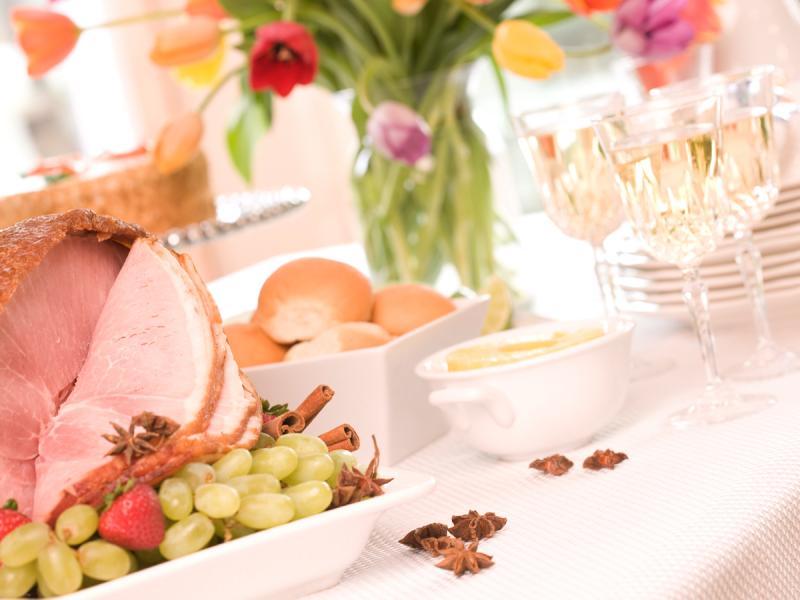Still time for Easter lamb and ham wine. For those with a perverse sense of humor, I think I'll recommend something that goes with rabbit as well. Maybe next week. Rob Dolan Wines White Label Shiraz Yarra Valley Australia 2013 is a great buy around $17. Halliday rated it 95 points. He is a generous rater but an Aussie expert. I say 92 plus 1 price point. Fruit forward, look for cherry, pepper, barrel spice nose. Tannins still a bit chewy, but color and fruit say it can cellar at least 8-10 years. Read label carefully. Dolan's been making wine for 30 years. His True Colors labels are all decent and priced favorably around $15. The Shiraz/Merlot 2012, '13 and 2015 are solid 89-90s. Going upscale, look to Raymond Vineyard & Cellar Generations Cab 2009, 94 McD at $125. Jeannie Cho Lee gave it 83 points, WS 95, WE 94. Lee also down rated the 2013. Possibly Jeannie's palate deplores the Raymond profile. Raymond's Napa Valley Reserve 2013 is a solid 90 points under $30, a terrific QPR. Parker named the Generations 2014, 97 points, a "Wow wine." I have not sampled any but the consensus is strong around 92-95 points. Raymond makes a sofer style of fruit-forward Cabs.
Let's start ham off with my true preference to accompany. Beer! A couple of rules of thumb are: with salty ham such as Smithfield, pale ale and pilsner work best; for sweet glazed hams, try Stout and British browns. If you prefer wine, I tend to enjoy drier German Riesling, Italian Pinot Grigio from the Alto Adige or Alsatian Pinot Gris. Many folks recommend Red Burgundy. I am underwhelmed by the pairing, unless you are a fan of lightly salted, dry cured ham. Most European hams are at least slightly salty, and some smoky or spicy. A good idea is to think of famous hams.
Tasso, Speck, Prosciutto, Parma, Black Forest, Iberica, and Virginia ham, then consider the wine that is produced in their areas. Can you name a famous French ham? Have you ever tried a Virginia Surryano ham from Edwards Smokehouse of Virginia?
I recommend Jamon Iberico, especially Iberica de Bellota, (acorn-fed, free-range, sweet, dry and nutty, $89/lb. or $800 for a 9-lb. boneless). Commonsewers know this as Pata Negra, which occurs due to its many special restrictions and accounts for about 5 percent of Spain's production, and it is killer. Serrano ham with Manzanilla sherry is a match made in heaven. You may try Cava or sweeter Spanish reds that some recommend. I am usually disappointed. Following is a well-researched article from Iberiko written by Eleanor: www.iberiko.com/blog/chorizo-and-jamon-iberico-wine-pairings-part-1-best.... No sense in reinventing the wheel.
For those traveling, light hip pocket, look into Serrano. Serrano, Iberico and prosciutto are dry cured, not smoked. In America we name them green hams, Smithfield, for example, which most name a dry cured country ham. I prefer "salt cured." I have never succeeded with them.
Anecdotally, I went through the long, time-consuming process and explained to all my assembled family that Smithfield, free-range, peanut-fed ham was the ne plus ultra of Eastern Shore and Virginia culinary delights, second only to ahrsters. And prior to serving my first attempt, 1971, I gave Bro Dan a taste. "What do you think?" After careful consideration and with a wry smile he replied, "I think we should grill some steaks." And we did!
Wet cured hams are usually labeled cooked. To serve hot, please hold temp to 140 degrees F, or they dry out. Typical to our area stores is spiral-cut ham. Try 325 in a standard oven or 300 F in a preheated convection oven. If you don't have a probe thermometer, put down the paper and go get one right now. I still use one! Cook a whole 10-14-pounder 15 minutes/lb. For a half ham, 7-9-lbs., 325 for 10 minutes/lb. No peeking into the oven. After the time has passed, open oven to check temp. May need a bit more time. Please do not overcook. The package instructions work. Most of the glazes are awful for my palate. Make your own. Allow ham to stand at least 20 minutes before carving. Most meat improves when it's allowed to rest. The juices and temperature distribute themselves better. Answer to question above: Jamon de Paris and Jambon de Bayonne (French prosciutto).





















































